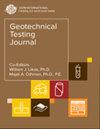路面用泡沫沥青稳定颗粒基和再生混合料的实验室疲劳特性
IF 1.2
4区 工程技术
Q3 ENGINEERING, GEOLOGICAL
引用次数: 0
摘要
泡沫沥青稳定为新路面的建设或修复治疗提供了可持续的解决方案,同时也改善了路面结构的性能。这项技术可以100%利用现有的路面,这将减少采石场资源的使用,降低材料运输成本。近年来,泡沫沥青稳定路面的应用取得了一定的进展。然而,在本文研究之前,并没有针对FBS材料建立具体的澳大利亚性能关系。此外,缺乏专门开发的测试程序来制造和评估FBS传统和再生路面材料的抗疲劳开裂性。本文介绍了实验室表征和疲劳关系的发展,以预测FBS材料的性能。为此,使用四点弯曲梁系统进行了包括弯曲疲劳、模量和强度测试在内的实验室实验。实验室研究选择了五种不同的主体材料,包括三种碎石和两种再生混合物,其中50%的再生沥青路面和80%的再生水泥处理碎石。总共测试了8种FBS混合料,它们具有不同的主体材料,泡沫沥青含量为2 - 4%,水合石灰含量为1 - 2%。建立了FBS颗粒基与再生共混物疲劳性能测试分析方法。利用实验室测试结果,开发了FBS材料(包括回收共混物)的特定实验室疲劳关系。发现沥青的弯曲模量、弯曲强度模量比和体积是影响FBS材料疲劳寿命的主要参数,并据此建立了预测模型。该研究将有助于FBS柔性路面厚度设计中基于性能的在役疲劳模型的后续开发。本文章由计算机程序翻译,如有差异,请以英文原文为准。
Laboratory Fatigue Characterization of Foamed Bitumen Stabilized Granular Base and Recycled Blends for Pavements
Foamed bitumen stabilization offers a sustainable solution for the construction of new pavements or rehabilitation treatments while also improving the performance of pavement structures. This technique allows up to 100 % of the existing pavements to be used, which will lead to lower use of quarry resources and reduced material transportation cost. In recent years, there have been advances in the use of foamed bitumen stabilized (FBS) pavements. However, prior to the research in this paper, no specific Australian performance relationship had been developed for FBS materials. Also, there was a lack of test procedures specifically developed to manufacture and evaluate the fatigue cracking resistance of FBS conventional and recycled pavement materials. This paper presents the laboratory characterization and development of a fatigue relationship to predict performance of FBS materials. For this purpose, laboratory experiments were undertaken including flexural fatigue, modulus, and strength tests using a four-point bending beam system. Five different host materials were selected for laboratory investigations, including three crushed rocks and two recycled blends incorporating 50 % reclaimed asphalt pavement and 80 % recycled cement–treated crushed rock. A total of eight FBS mixes were tested with varying host materials, foamed bitumen content from 2 to 4 %, and hydrated lime content of 1 or 2 %. A testing procedure to measure and analyze the fatigue performance of FBS granular base and recycled blends was produced. Using the laboratory test results, a specific laboratory fatigue relationship for FBS materials, including recycled blends, is developed. The flexural modulus, flexural strength-to-modulus ratio, and volume of bitumen were found to be major parameters affecting the fatigue life of FBS materials and were consequently employed to develop the predictive model. This research will assist with the subsequent development of a performance-based in-service fatigue model for thickness design of FBS flexible pavements.
求助全文
通过发布文献求助,成功后即可免费获取论文全文。
去求助
来源期刊

Geotechnical Testing Journal
工程技术-地球科学综合
CiteScore
3.10
自引率
12.50%
发文量
53
审稿时长
3.6 months
期刊介绍:
The purpose of the Geotechnical Testing Journal is (1) to provide a high-quality publication that informs the profession of new developments in soil and rock testing and related fields; (2) to provide a forum for the exchange of information, particularly that which leads to the development of new test procedures; and (3) to stimulate active participation of the profession in the work of ASTM International Committee D18 on Soil and Rock and related information.
The editorial scope of this journal covers test methods for soil and rock, sampling, nomenclature, and practices relating to the determination of properties and behavior of soil and rock for engineering purposes, and for soil as a medium for plant growth.
 求助内容:
求助内容: 应助结果提醒方式:
应助结果提醒方式:


